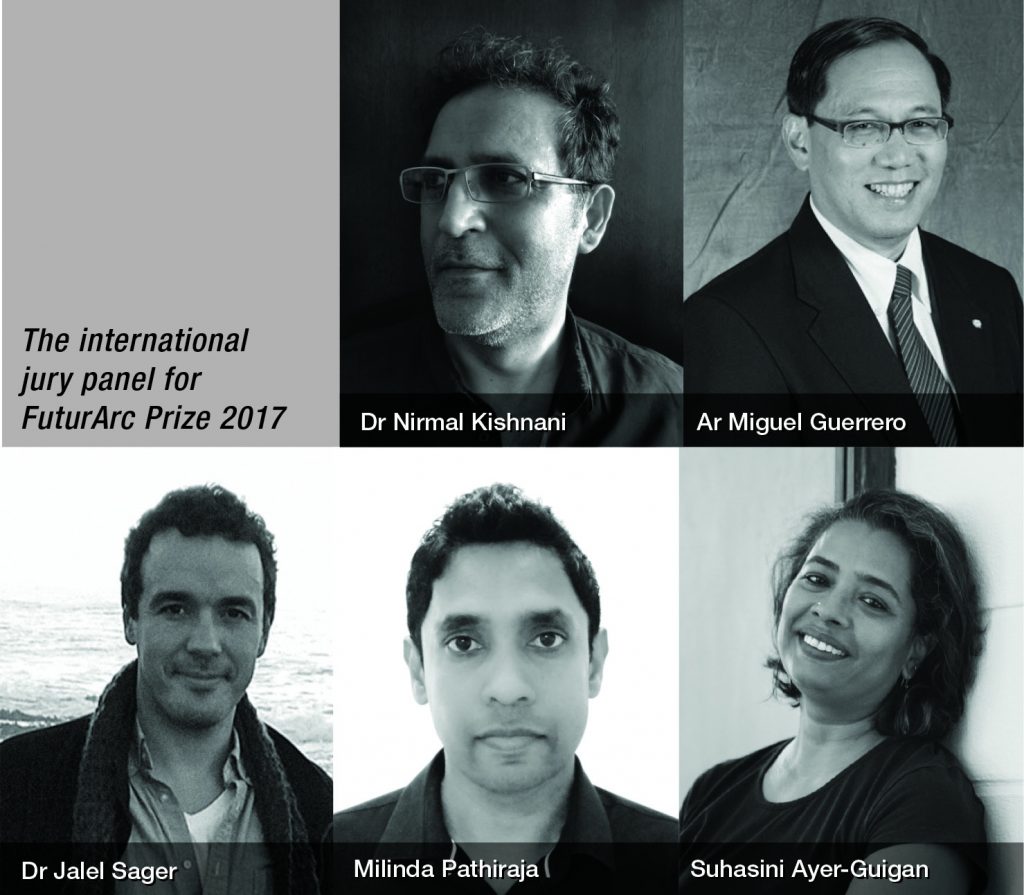Mar - Apr 2017
FuturArc Prize 2017
March 31, 2017

The 2017 cycle of the annual FuturArc Prize took place from September 2016 to December 2016. The competition brief—to design a Green building that serves more than its intended purpose in connecting or repairing the systems in which it is embedded—attracted interest from more than 500 professionals and students from Asia and beyond.
The brief in detail: An architecture for the common good
The goal of Green is to create more responsible buildings. But a Green building, no matter how well-intentioned, typically looks inwards within the boundaries of project site and building shell. The search for sustainable solutions, we now know, cannot be confined to the scale of standalone buildings. In Asia, these past decades, we have seen neighbourhoods and public space replaced by private enclaves. There has been a systemic degradation of parks, rivers and water bodies. These transformations affect the well-being of all citizens, especially those with less income.
The search for a sustainable Asia calls for a new way of seeing buildings and their relation to cities. Buildings are embedded within wider urban systems such as energy and water grids, biodiversity and habitat networks, public and social space. The health of each system is affected by every insertion, every new development. When systems are degraded, as a result of rampant or thoughtless development, the city and its inhabitants suffer.
But what if buildings—even ones that are privately owned or profitmaking— were designed to connect or repair the systems in which they are embedded? What if a shopping centre becomes a part of a biodiversity network? What if a condominium is also a community farm, shared by the neighbourhood? What if an office building is part of an urban flood protection system?
The question before us is ‘how’. How do we integrate architectural design and engineering with landscape design and urban planning? How do we create new social contracts between building owners and the community? How might governments craft policy so that all developers, even the ones who seek to make a quick profit, have an obligation to facilitate common good?
The goal of this competition is to craft a vision for a new kind of urban development, one that is generous, restorative and net-positive. Can each project—if it engages systems in a positive way—turn the Asian city around, restoring natural and social capital that has been eroded in recent decades?
Evaluation criteria
The international panel of jurors is looking for solutions that are plausible and rooted in local conditions. Judging will be based on these equally weighted criteria (20 percent each):
- Embeddedness: Explain which systems are engaged and how this development, on this site, connects with the flows and networks around it. For e.g., energy and materials; water and hydrology; biodiversity and habitats; food and nutrient cycles; public and social space, etc. The selection of systems must be explained with relevant analyses of site and context.
- Impact: Explain how the development contributes to the wider good. This cannot be at the expense of the project’s own programmatic goals, i.e., it must successfully function as a residential or commercial development.
- Innovation: Explore new ways to engage systems. How does architectural form and typology affect the potential to engage systems? How might the mechanical systems inside a building connect with the natural systems outside? How does site planning alter the relationship of a development to the community around it?
- Replicability: Show what it would mean to the city if more buildings were designed this way, i.e., show how these ideas, translated to policy, might alter the city over time. In January 2017, the assessment committee had done the preliminary review and over a period of four weeks from mid-January to mid-February, the jury panel had reviewed all the entries. At a jury meeting in March, a shortlist of entries was discussed and final winners determined. There will be a special supplement in the coming FuturArc May-June Green Awards 2017 issue to reveal more details about the meeting and to showcase the winning entries. The results will also be announced and the winners awarded at the BCI Asia award ceremonies held from mid-May to mid-June 2017.
To read the complete article, get your hardcopy at our online shop/newsstands/major bookstores; subscribe to FuturArc or download the FuturArc App to read the issues!
Previously Published Happening
Contact us at https://www.futurarc.com/contact-us for older articles.

